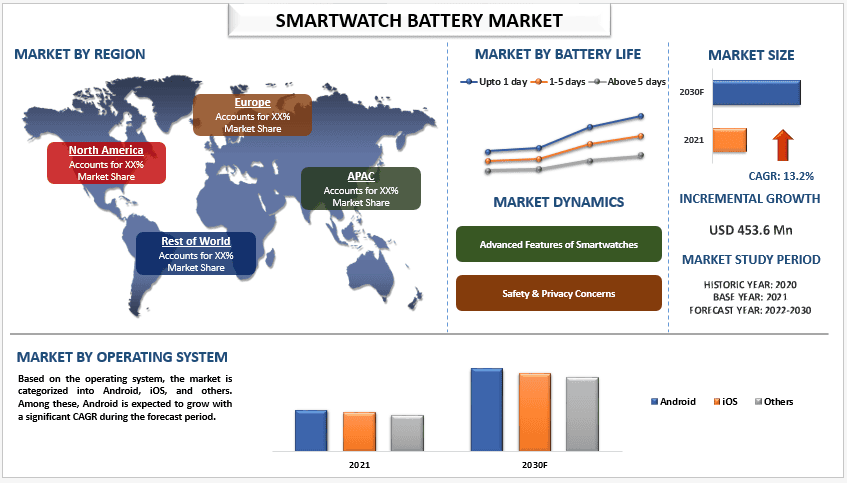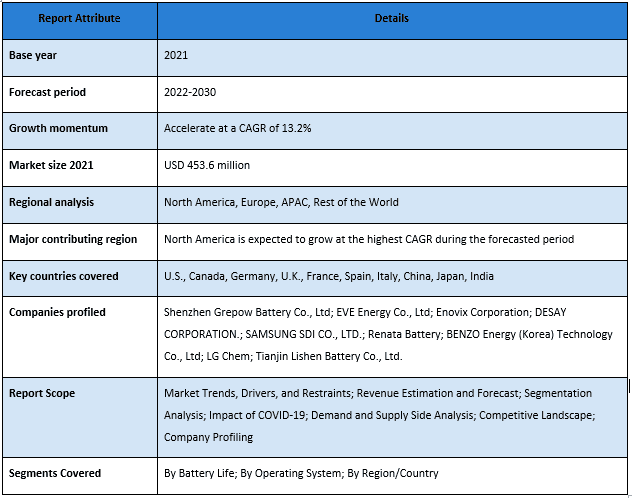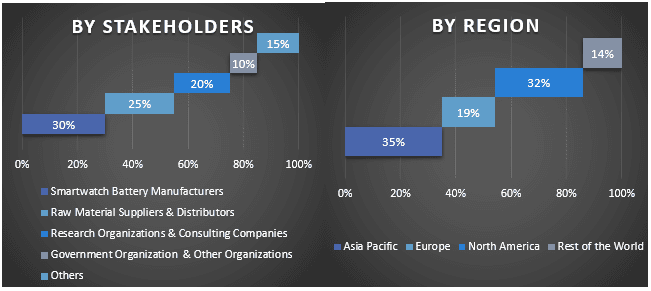
글로벌 스마트워치 배터리2021년 시장 가치는 4억 5,360만 달러였으며 2022년부터 2030년까지 연평균 성장률(CAGR) 13.2%로 성장할 것으로 예상됩니다.배터리는 음극, 양극 및 전해질의 세 가지 기본 구성 요소로 구성된 전기 화학 전지의 조합입니다. 배터리 음극과 양극이 회로의 한쪽 끝에서 다른 쪽 끝으로 전자가 이동할 수 있도록 하는 외부 장치에 연결되면 전지 내에서 생화학 반응이 일어납니다. 스마트워치는 시간 표시를 포함한 여러 기능을 갖춘 터치스크린 디스플레이가 있는 전자 손목시계이지만 대부분의 제조업체는 리튬 이온 배터리를 사용합니다. 충전식 리튬 배터리는 메모리 효과 없이 여러 번의 충전 사이클을 가능하게 하므로 긴 배터리 수명에 적합합니다. 스마트워치의 첨단 기능과 젊은 층 사이에서 웨어러블 기술에 대한 증가하는 추세와 같은 요인이 스마트워치 배터리 시장에 대한 수요를 증가시키고 있습니다. 시장의 주요 기업들은 한 번의 충전으로 더 나은 배터리 수명을 갖춘 기술적으로 진보된 기능을 갖춘 스마트워치를 제공합니다.예를 들어, 2023년 3월에 1.28인치 디스플레이와 20일 배터리 수명을 가진 Amazfit GTR Mini가 인도에서 출시되었습니다.
Shenzhen Grepow Battery Co., Ltd; EVE Energy Co., Ltd; Enovix Corporation; DESAY CORPORATION.; SAMSUNG SDI CO., LTD.; Renata Battery; BENZO Energy Technology Co., Ltd; LG Chem; Tianjin Lishen Battery Co., Ltd.는 시장의 주요 업체 중 일부입니다. 이러한 업체들은 첨단 혁신적인 제품/기술을 고객에게 제공하기 위해 여러 M&A와 파트너십을 체결했습니다.
보고서에 제시된 통찰력
“배터리 수명 중 1-5일 세그먼트가 2021년에 상당한 시장 점유율을 차지했습니다.”
배터리 수명을 기준으로 시장은 최대 1일, 1-5일, 5일 이상으로 세분화됩니다. 1-5일 세그먼트는 2021년에 상당한 시장 점유율을 차지했습니다. 이는 주로 스마트워치에서 더 긴 배터리 수명을 달성하는 데 기여한 배터리 기술의 발전에 기인합니다. 배터리 효율성, 에너지 관리 시스템 및 스마트워치의 전반적인 디자인 개선을 통해 날렵하고 컴팩트한 폼 팩터를 유지하면서 배터리 수명을 연장할 수 있게 되었습니다. 또한 스마트워치는 더 이상 시간 표시 장치가 아니라 피트니스 추적, 심박수 모니터링, 수면 추적, 스마트폰 알림 등을 제공합니다. 이러한 고급 기능은 더 많은 전력이 필요하며 사용자는 이러한 기능을 처리하면서도 적절한 배터리 수명을 유지하기를 기대합니다.
“운영 체제 중 Android가 예측 기간 동안 상당한 CAGR로 성장할 것으로 예상됩니다.”
운영 체제를 기준으로 시장은 Android, iOS 및 기타로 분류됩니다. 이 중 Android는 예측 기간 동안 상당한 CAGR로 성장할 것으로 예상됩니다. 이는 주로 Android가 해당 제품에 비해 제공하는 이점 때문입니다. Android는 타사 앱 및 서비스와의 더 나은 통합을 제공합니다. 다양한 앱 및 서비스와의 호환성은 Android 기반 스마트워치의 기능과 사용성을 향상시켜 즐겨 사용하는 앱 및 서비스와의 원활한 통합을 중요하게 생각하는 사용자를 유치합니다. Android 호환 스마트워치에 대한 수요 증가는 Android 운영 체제를 지원하는 배터리에 대한 수요 증가로 이어집니다.
“북미 지역은 2021년에 상당한 시장 점유율을 차지할 것으로 예상됩니다.”
2021년에는 북미 지역이 2021년에 상당한 시장 점유율을 차지할 것으로 예상됩니다. 이는 주로 해당 지역의 스마트워치 수요 증가에 기인합니다. 여기의 고객은 주로 더 긴 배터리 수명과 신체 균형을 추적하는 편의성을 우선시합니다. 또한 스마트워치의 인기가 높아지고, 기술이 발전하고, 건강 및 웰빙 트렌드가 증가하고, 기술에 정통한 소비자층이 형성되는 등의 요인도 시장 성장에 기여하고 있습니다. 또한 스마트워치 기술의 발전으로 더 많은 전력을 소비하는 기능과 더 큰 디스플레이가 제공되어 더 높은 용량의 배터리가 필요하게 되었습니다. 소비자는 하루 종일 중단 없이 사용하기 위해 더 긴 배터리 수명을 기대하며, 이는 효율적이고 오래 지속되는 배터리에 대한 수요 증가로 이어집니다.예를 들어, 2022년 9월 Apple은 새로운 스마트워치 라인업인 Series 8, new SE 및 Ultra를 출시했습니다. Apple은 Ultra 모델이 정상적인 사용 시 최대 36시간에 달하는 모든 Apple Watch 중에서 최고의 배터리 수명을 가지고 있다고 주장합니다.
스마트워치 배터리 시장 보고서 범위

이 보고서를 구매해야 하는 이유:
- 본 연구에는 인증된 주요 업계 전문가가 검증한 시장 규모 및 예측 분석이 포함되어 있습니다.
- 이 보고서는 전반적인 업계 성과를 한눈에 볼 수 있도록 간략하게 검토합니다.
- 이 보고서는 주요 비즈니스 재무, 제품 포트폴리오, 확장 전략 및 최근 개발에 중점을 두고 주요 업계 동료에 대한 심층 분석을 제공합니다.
- 업계에서 널리 퍼져 있는 동인, 제약, 주요 트렌드 및 기회에 대한 자세한 검토.
- 이 연구는 다양한 세그먼트에서 시장을 포괄적으로 다룹니다.
- 업계의 심층적인 지역별 분석.
맞춤 설정 옵션:
글로벌 스마트워치 배터리 시장은 요구 사항 또는 기타 시장 부문에 따라 추가로 맞춤 설정할 수 있습니다. 이 외에도 UMI는 귀하의 고유한 비즈니스 요구 사항을 이해하므로 귀하의 요구 사항에 완벽하게 맞는 보고서를 받으려면 언제든지 저희에게 문의하십시오.
목차
스마트워치 배터리 시장 분석 (2022-2030)을 위한 연구 방법론
글로벌 스마트워치 배터리 시장의 채택을 생성하고 분석하기 위해 전 세계 주요 지역에서 스마트워치 배터리의 과거 시장을 분석하고, 현재 시장을 추정하고, 미래 시장을 예측하는 세 가지 주요 단계가 수행되었습니다. 과거 시장 수치를 수집하고 현재 시장 규모를 추정하기 위해 광범위한 2차 연구가 수행되었습니다. 둘째, 이러한 통찰력을 검증하기 위해 수많은 결과와 가정이 고려되었습니다. 또한 글로벌 스마트워치 배터리 시장의 가치 사슬 전반에 걸쳐 업계 전문가와의 광범위한 1차 인터뷰가 수행되었습니다. 1차 인터뷰를 통해 시장 수치를 가정하고 검증한 후, 전체 시장 규모를 예측하기 위해 상향식/하향식 접근 방식을 사용했습니다. 그 후 시장 분석 및 데이터 삼각 측량 방법을 채택하여 산업의 세그먼트 및 하위 세그먼트의 시장 규모를 추정하고 분석했습니다. 자세한 방법론은 다음과 같습니다.
과거 시장 규모 분석
1단계: 2차 자료에 대한 심층 연구:
스마트워치 배터리 시장의 과거 시장 규모를 얻기 위해 다음과 같은 회사 내부 자료를 통해 자세한 2차 연구가 수행되었습니다.연례 보고서 및 재무 제표, 성과 발표, 보도 자료 등,및 다음을 포함한 외부 자료저널, 뉴스 및 기사, 정부 간행물, 경쟁사 간행물, 부문 보고서, 타사 데이터베이스 및 기타 신뢰할 수 있는 간행물.
2단계: 시장 세분화:
스마트워치 배터리 시장의 과거 시장 규모를 얻은 후, 주요 지역의 다양한 세그먼트 및 하위 세그먼트에 대한 과거 시장 통찰력과 점유율을 수집하기 위해 자세한 2차 분석을 수행했습니다. 주요 세그먼트는 배터리 수명 및 운영 체제로 보고서에 포함됩니다. 또한 해당 지역에서 테스트 모델의 전반적인 채택을 평가하기 위해 국가별 분석이 수행되었습니다.
3단계: 요인 분석:
다양한 세그먼트 및 하위 세그먼트의 과거 시장 규모를 획득한 후, 스마트워치 배터리 시장의 현재 시장 규모를 추정하기 위해 자세한요인 분석을 수행했습니다. 또한 스마트워치 배터리의 다양한 배터리 수명 및 운영 체제와 같은 종속 및 독립 변수를 사용하여 요인 분석을 수행했습니다. 전 세계 스마트워치 배터리 시장의 주요 파트너십, 합병 및 인수, 사업 확장 및 제품 출시를 고려하여 수요 및 공급 측면 시나리오에 대한 철저한 분석이 수행되었습니다.
현재 시장 규모 추정 및 예측
현재 시장 규모 조정:위의 3단계에서 얻은 실행 가능한 통찰력을 바탕으로 현재 시장 규모, 글로벌 스마트워치 배터리 시장의 주요 업체 및 세그먼트의 시장 점유율에 도달했습니다. 필요한 모든 점유율 분할 및 시장 세분화는 위에 언급된 2차 접근 방식을 사용하여 결정되었으며 1차 인터뷰를 통해 검증되었습니다.
추정 및 예측:시장 추정 및 예측을 위해 동인 및 트렌드, 제약 및 이해 관계자를 위해 사용할 수 있는 기회를 포함한 다양한 요인에 가중치가 할당되었습니다. 이러한 요인을 분석한 후, 주요 시장 전반에 걸쳐 다양한 세그먼트 및 하위 세그먼트에 대한 2030년 시장 예측에 도달하기 위해 적절한 예측 기술, 즉 상향식/하향식 접근 방식이 적용되었습니다. 시장 규모를 추정하기 위해 채택된 연구 방법론에는 다음이 포함됩니다.
- 수익(USD) 측면에서 산업의 시장 규모와 주요 시장 전반에 걸쳐 스마트워치 배터리 시장의 채택률
- 시장 세그먼트 및 하위 세그먼트의 모든 점유율, 분할 및 분류
- 제공 제품 측면에서 글로벌 스마트워치 배터리 시장의 주요 업체. 또한, 빠르게 성장하는 시장에서 경쟁하기 위해 이러한 업체들이 채택한 성장 전략
시장 규모 및 점유율 검증
1차 조사:주요 지역의 최고 경영진(CXO/VP, 영업 책임자, 마케팅 책임자, 운영 책임자, 지역 책임자, 국가 책임자 등)을 포함한 주요 의견 리더(KOL)들과 심층 인터뷰를 진행했습니다. 1차 조사 결과를 요약한 후 통계 분석을 수행하여 명시된 가설을 입증했습니다. 1차 조사의 입력 사항은 2차 조사 결과와 통합되어 정보를 실행 가능한 통찰력으로 전환했습니다.
다양한 지역의 1차 참여자 분할

시장 엔지니어링
데이터 삼각 측량 기술을 사용하여 전체 시장 추정을 완료하고 글로벌 스마트워치 배터리 시장의 각 세그먼트 및 하위 세그먼트에 대한 정확한 통계 수치를 얻었습니다. 배터리 수명 및 운영 체제 분야의 다양한 매개변수와 추세를 연구한 후 데이터는 여러 세그먼트 및 하위 세그먼트로 분할되었습니다.
글로벌 스마트워치 배터리 시장 연구의 주요 목표
글로벌 스마트워치 배터리 시장의 현재 및 미래 시장 동향이 연구에서 밝혀졌습니다. 투자자는 연구에서 수행된 정성적 및 정량적 분석을 기반으로 투자를 결정하는 전략적 통찰력을 얻을 수 있습니다. 현재 및 미래 시장 동향은 지역 수준에서 시장의 전반적인 매력을 결정하여 산업 참여자가 미개척 시장을 활용하여 선점 우위를 확보할 수 있는 플랫폼을 제공합니다. 연구의 다른 정량적 목표는 다음과 같습니다.
- 가치(USD) 측면에서 스마트워치 배터리 시장의 현재 및 예측 시장 규모를 분석합니다. 또한, 다양한 세그먼트 및 하위 세그먼트의 현재 및 예측 시장 규모를 분석합니다.
- 연구의 세그먼트에는 배터리 수명 및 운영 체제 영역이 포함됩니다.
- 스마트워치 배터리에 대한 규제 프레임워크 정의 및 분석
- 다양한 중개인의 존재와 관련된 가치 사슬을 분석하고 업계의 고객 및 경쟁사 행동을 분석합니다.
- 주요 지역에 대한 스마트워치 배터리 시장의 현재 및 예측 시장 규모를 분석합니다.
- 보고서에서 연구된 주요 지역의 주요 국가는 아시아 태평양, 유럽, 북미 및 기타 지역을 포함합니다.
- 스마트워치 배터리 시장의 회사 프로필 및 빠르게 성장하는 시장에서 지속하기 위해 시장 참여자가 채택한 성장 전략
- 업계의 심층적인 지역 수준 분석
관련 보고서
이 상품을 구매한 고객님들도 함께 구매하신 상품










